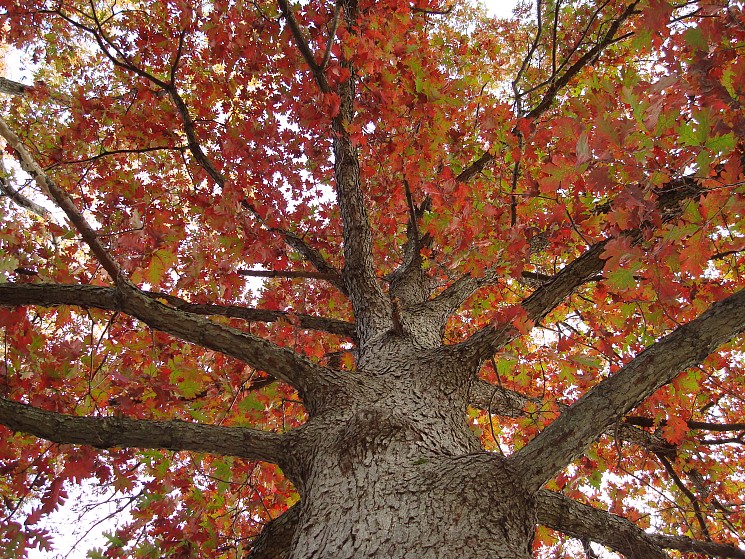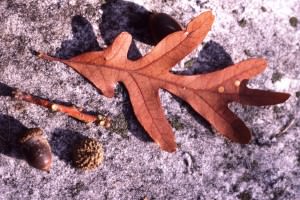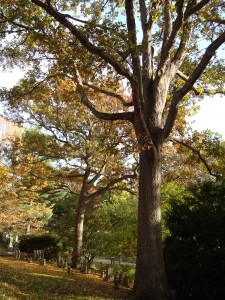Quercus alba

One of the most magnificent of North American trees, Quercus alba, or White Oak has long been equated with strength and permanency. Native to a range spanning Maine to Florida, west of Minnesota and Texas, these trees with a broad spreading habit have been widely modeled to symbolize trees in art for centuries.
Deeply rooted in American history from our colonial era – its wood was one of our first profitable exports. In later years its wood helped build New England’s maritime fleet and wealth as well as portions of the U. S. S. Constitution, today berthed at the Charlestown Navy Yard.
 The fruit of the oaks, the well known acorn, may be the most recognizable aspect of these trees. This nut ¾ – 1 inch long is enclosed by a chestnut-brown bowl-like cup made of a large number of small scales which attach acorn to branch stem. It may be twenty to forty years before a tree produces its first crop of fruit, as many as three or four thousand acorns, but thereafter will bear heavy crops irregularly. Acorns provide food for Mount Auburn’s squirrels, chipmunks, and mice, as well as for blue jays, crows, brown thrashers, mourning doves,white-breasted nuthatches, various woodpeckers, and numerous other birds.
The fruit of the oaks, the well known acorn, may be the most recognizable aspect of these trees. This nut ¾ – 1 inch long is enclosed by a chestnut-brown bowl-like cup made of a large number of small scales which attach acorn to branch stem. It may be twenty to forty years before a tree produces its first crop of fruit, as many as three or four thousand acorns, but thereafter will bear heavy crops irregularly. Acorns provide food for Mount Auburn’s squirrels, chipmunks, and mice, as well as for blue jays, crows, brown thrashers, mourning doves,white-breasted nuthatches, various woodpeckers, and numerous other birds.
 During November their autumnal foliage claims the cemetery’s landscape stage after most other deciduous trees’ leaves have fallen to the ground. The 4-8 inch long leaves with 5-9 inchrounded lobes exhibit colors varying from a rich red to a wine color to brown. Often the white oak loses its leaves begrudgingly somewhere after Thanksgiving, with others clinging to branches even after winter’s first snows fall. Edna St. Vincent Millay captures this best:
During November their autumnal foliage claims the cemetery’s landscape stage after most other deciduous trees’ leaves have fallen to the ground. The 4-8 inch long leaves with 5-9 inchrounded lobes exhibit colors varying from a rich red to a wine color to brown. Often the white oak loses its leaves begrudgingly somewhere after Thanksgiving, with others clinging to branches even after winter’s first snows fall. Edna St. Vincent Millay captures this best:
“but my heart goes out to the oak leaves that are the last to sigh ‘Enough’ and lose their hold.”
Earlier in the year these leaves were eaten by numerous moth larvae including imperial, polyphomus, luna, rosy maple and the more destructive winter and gypsy. Also, butterly larvae such as striped hairstreak, Edward’s hairstreak, and juvenal’s dusky wingfed on these leaves.
White oak leaves are also found carved onto numerous monuments throughout the cemetery serving as symbols of eternity, honor, strength, endurance and even husbands. White oaks are long-lived, one in Buena Vista, Virginia is more than 460 years old. Of the more than seventy white oaks at Mount Auburn we have six that pre-date the cemetery’s 1831 founding. On your next trip here visit one or all of our over two-hundred year old white oaks found on Primrose Path, Indian Ridge Path, Rosebay Path, Pyrola Path, Bellwort Path, and Magnolia Avenue.
*This Horticulture Highlight was originally published in the November 2009 issue of the Friends of Mount Auburn electronic newsletter.
Leave a Reply